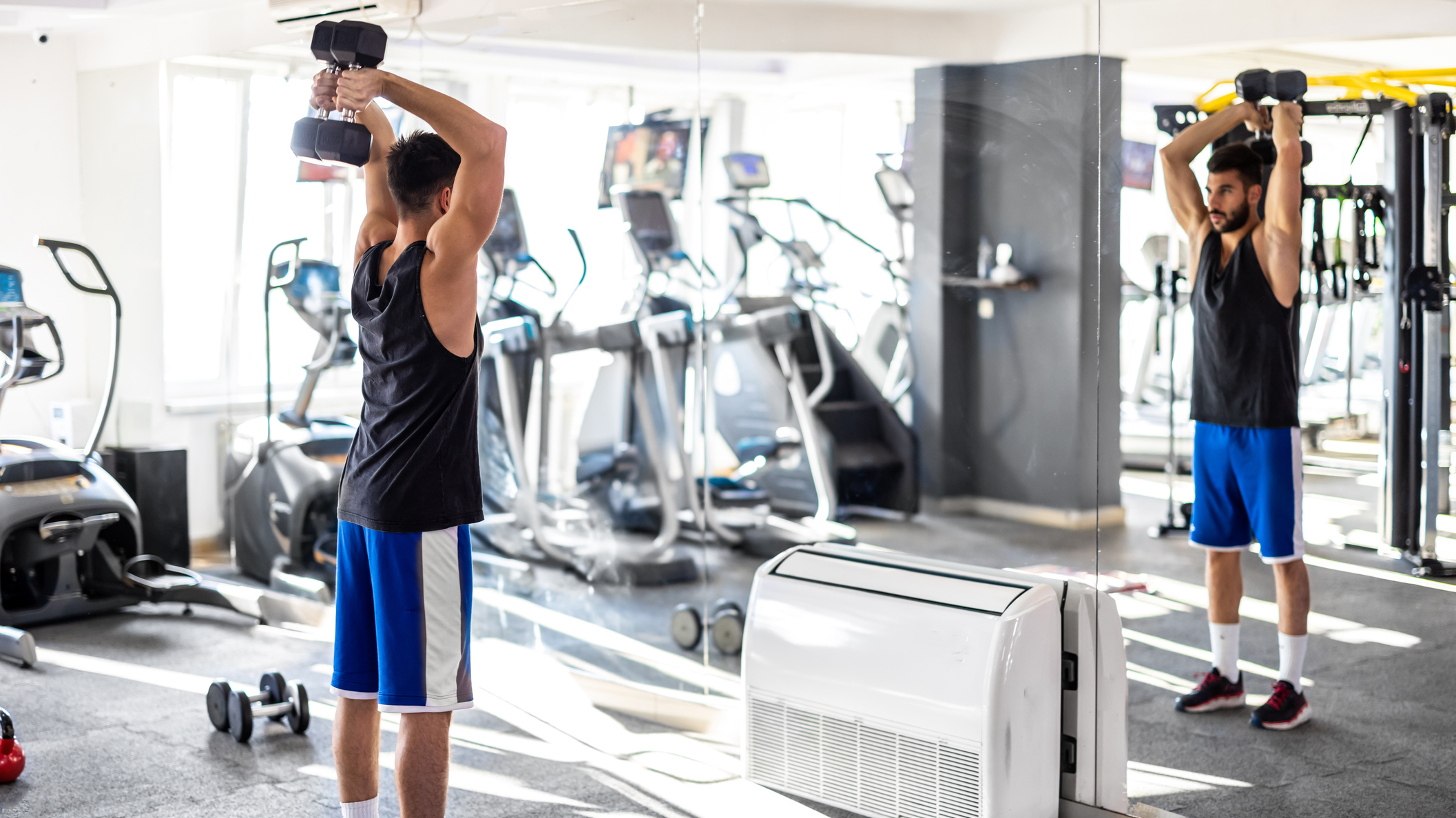How To Do The Overhead Dumbbell Triceps Extension
Bulk up the back of your arms with this simple but effective exercise

Take a look around at your fellow gym-goers next time you visit the weights room and it’s almost certain that you’ll see one or two of them doing biceps curls or some other laser-focused biceps exercise.
It’s far rarer that you’ll spot someone paying similar attention to their triceps. That is a darn shame, because if you’re chasing sleeve-bursting upper arms, you need titanic triceps just as much as—if not more than—bulging biceps.
Some of the best triceps exercises, such as the push-up and bench press, work the triceps as a secondary muscle, but the triceps extension puts these muscles squarely in the limelight. As a result of this extra focus, you should find that your triceps get stronger in rapid fashion.
Read on to find out how to nail the dumbbell overhead triceps extension, along with a few other effective triceps-targeting lifts, as recommended by strength and conditioning coach Ryan Horton of Horton Barbell.
Ryan Horton is the owner of Horton Barbell. He began his career as a strength and conditioning coach in 2004, holding positions ranging from assistant coach to director of strength and conditioning at a number of US universities, including Temple University. Before opening Horton Barbell, he held the position of director of applied sports science with the Georgia Tech American football team. He graduated with a BA in exercise physiology from Otterbein University in Ohio.
How To Do The Overhead Dumbbell Triceps Extension
The overhead triceps extension can be performed standing, sitting on a bench set at an incline or decline or lying down. Each variation will allow you to make the exercise slightly easier or harder, depending on your range of movement around your shoulders and upper back.
You can also perform this move with a barbell, EZ-bar, a single kettlebell or a single dumbbell. The advantage of doing it with a dumbbell in each hand is that you will be able to identify and address any strength imbalances on either side.
And because it can ruthlessly expose any weaknesses, the overhead dumbbell extension should be considered a tough exercise to be performed carefully and with light weights to begin with to minimize the risk of injury.
Sign up for workout ideas, training advice, reviews of the latest gear and more.
The Set-Up
If new to this exercise, Horton recommends starting out with the overhead dumbbell triceps extension performed in a seated position, either supported or unsupported.
“Hold dumbbells and sit on the end of a bench,” says Horton. You can do this with a backrest too, just set the bench to just shy of a 90° angle. “Press the dumbbells up to full extension overhead. Try to keep your elbows pointed forwards as much as possible.” Once in position, aim to keep your elbows in the same place throughout.
The Movement
“Bend your elbows to lower the dumbbells behind your head, before pressing the weights back up to full extension,” says Horton.
Common Mistakes When Performing The Overhead Dumbbell Triceps Extension
1. Poor Mobility
The overhead dumbbell triceps extension requires a surprising degree of shoulder mobility to do properly. “Most people are probably not going to have their elbows dead ahead when they do this,” says Horton, but that’s what you’re aiming for.
“If poor shoulder mobility limits your range of motion, it’s going to put everything in a really awkward position and you won’t be able to execute the move properly.”
To address this limitation, Horton suggests using resistance band shoulder dislocations and similar shoulder stretches to unlock greater flexibility in the pecs before returning to this exercise.
2. Performing Partial Reps
The second most common mistake concerns range of motion, perhaps because of the aforementioned limitations in mobility, or because you’ve optimistically selected too heavy a pair of dumbbells.
If you do this, you’ll only be able to perform a partial rep, meaning the muscles aren’t working to their full potential and range of motion is restricted further.
If you want to shift more weight or struggle with the mobility element, Horton suggests using alternative triceps exercises such as the triceps push-down, dumbbell skullcrusher or diamond push-up.
Benefits Of The Overhead Dumbbell Triceps Extension
Unlike push-ups and overhead presses, which involve multiple muscle groups working in unison, the overhead dumbbell triceps extension is an isolation exercise that primarily targets the triceps. As such, it’s best served for building strength and size in the upper arms.
Horton says this can transfer to other exercises too, giving your overall gym game a lift. “Strengthening your triceps will carry over to being able to do more push-ups, bench more weight, and even increase your Olympic weightlifting lifts like the jerk or split jerk,” he explains.
You can also perform this triceps exercise at home—all you need is a pair of light to medium heavy dumbbells. And if you only have one pair of weights, you can easily modify the exercise by slowing down the tempo to make each rep harder, or just use one dumbbell at a time, held in both hands, to make it easier.
Drawbacks Of The Overhead Dumbbell Triceps Extension
Despite its many benefits, Horton says there are quite a few other triceps-targeted exercises he prefers to the overhead triceps extension, including dips and floor presses.
“When you really drill down into it, you can simply move more weight with other triceps movements,” he says, and more weight equals greater strength gains.
“The dip or close-grip floor press, which restricts range of motion to target the triceps and works the top half of the pressing movement, are fundamentally better triceps strength builders than a really isolated move like the overhead triceps extension.”
Overhead Dumbbell Triceps Extension Variations
One-arm overhead dumbbell triceps extension
By using dumbbells instead of a EZ-bar for the overhead extension you work each arm separately and ensure one stronger side isn’t carrying the weaker one, but it’s also worth doing the exercise with one arm at a time. This lets you focus on perfect form in that one arm, and also allows for a greater range of motion so you can be sure you’re working every part of the triceps with the move. As with all forms of the exercise, make sure you don’t overdo it with the weight you use and ideally you want to be able to rest the weight evenly in both palms.
Overhead cable triceps extension
If you use a cable machine instead of dumbbells to perform the exercise, the main benefit is a consistent level of resistance throughout the movement. Attach a handle to the low pulley on the machine and hold it in both hands above your head with your arms fully extended. Lower the rope behind you, keeping your upper arms stationary, then flex your triceps to return to the starting position.
Lying triceps extension

If you fancy a lie-down during your workout, move your triceps extensions to a bench. This can help you focus on the movement of your arms better than the standing variation, and both exercises produce the same benefits – namely bulkier upper arms.
Lie on a flat bench, holding the dumbbells above you with your arms extended and your palms facing each other. Bend at your elbows to lower the weights on either side of your head, keeping your upper arms stationary and making sure you don’t flare your elbows out to the sides. Slowly take the dumbbells back up to the starting position.

Harry covers news, reviews and features for Coach, Fit&Well and Live Science. With over a decade of training experience, he has tried everything from powerlifting to gymnastics, cardio to CrossFit, all in a bid to find fun ways of building a healthy, functional body.
- Nick Harris-FrySenior writer
